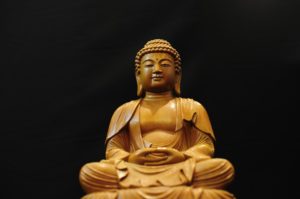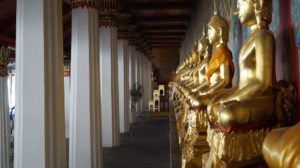(originally published as A NOTE ON THE DATING OF THE BUDDHA in the Middle Way, Journal of the Buddhist Society of the UK)
Most books available on Buddhism place the Buddha in the sixth century BCE (1) and the usually quoted dates are 563-483 BCE. Modern scholarship is now veering away (2) from this accepted range. A new dating proposed by Professor R. Gombrich, Boden Professor of Sanskrit at Oxford University, places the Buddha firmly in the fifth century BCE.
The importance of Professor Gombrich’s finding lies not only in obtaining correct dates. It both helps to reconcile a difference between the Theravada and Mahayana chronologies, and re-organises our understanding of the historical milieu of civilisations at the time, and thus of their interactions. This revision is based primarily on a reassessment of evidence which has been available for some time.
THREE CHRONOLOGIES
Southern Buddhism has tended to trust the long chronology which states that the Buddha’s final Nibbana took place 218 years before the inauguration of Emperor Asoka though the date of the latter was not correctly determined. Chronology from the religious chronicles of Southern Buddhist countries set the Buddha’s Parinibbana at 543/4 BCE, tracing this date back from those seen as marking the start of their “statehoods”. This dating formed the basis for the 1956 celebrations marking the 2500th anniversary of the Buddha’s passing. However, the assumptions used and the chronologies of royal lineages culminating in Emperor Asoka, are from a modern standpoint, doubtful. More recently, Indologists dated the Buddha’s Parinibbana at 483 BCE by ascertaining the inauguration of Emperor Asoka at c.269/267 BCE (3) and combining this date with the 218-year margin. The fixing of Emperor Asoka’s inauguration was based upon the overlapping reigns of five Greek kings to whom the emperor sent emissaries, as recorded in his thirteenth rock edict. The Mahayanist short chronology places the Buddha’s passing 100 – 116 years antecedent to Emperor Asoka’s inauguration. A typical Mahayana dating for the Buddha is 448 – 368 BCE (4).
All the datings hinge on the date of Emperor Asoka’s inauguration, with the revised dating independently corroborating something close to the short chronology.
EVIDENCE FROM THE TEXTS
The key to the revision is the Dipavamsa, a Sri Lankan chronicle on the fortunes of Buddhism in the Island and ancient India. It was composed in instalments, over several centuries and probably completed towards the end of the fourth century AD. Chapter six reveals 218 years as the span between the Buddha’s Parinibbna and Emperor Asoka’s inauguration, but earlier chapters provide information that can be sifted to give a more accurate time span.
 Listing in sequence the pupillary succession of five monks up to Emperor Asoka, the first of whom was ordained by the Buddha himself, the chronicle provides two key anchor points. Upali aged 60 ordained Dasaka 16 years after the Buddha’s Parinibbna, and Moggaliputta Tissa was 54 at Emperor Asoka’s inauguration. Formal ordination usually takes place after a training period and the novices must be at least 20 years of age according to the monks’ training rules.
Listing in sequence the pupillary succession of five monks up to Emperor Asoka, the first of whom was ordained by the Buddha himself, the chronicle provides two key anchor points. Upali aged 60 ordained Dasaka 16 years after the Buddha’s Parinibbna, and Moggaliputta Tissa was 54 at Emperor Asoka’s inauguration. Formal ordination usually takes place after a training period and the novices must be at least 20 years of age according to the monks’ training rules.
The Buddha ordained Upali, Upali ordained Dasaka, Dasaka ordained Sonaka, Sonaka ordained Siggava who ordained Mogalliputta Tissa. The Dipavamsa also provides the ages of each monk (a) at the time he ordained his pupil and (b) directly or indirectly his own age when he was ordained. Knowing (a) and (b) for each person in the above pupillary succession, we get:
i) 16 years after the Buddha’s Parinibbna, Upali ordains Dasaka then aged 20;
ii) when Dasaka is 45 (i.e. 25 years later), he ordains Sonaka, then aged 23;
iii) when Sonaka is 40 (i.e. 17 years later), he ordains Siggava, then aged 20;
iv) when Siggava is 64 (i.e. 44 years later), he ordains Moggaliputta Tissa then aged 20;
v) when Moggaliputta Tissa is 54 (i.e. 34 years later) Asoka becomes emperor.
Adding the underlined time-lapse gives 136 years between the Parinibbna and Asoka’s coronation.
There is about +-5/6 year margin of error to this figure (e.g. adding yearly terms without mentioning months (1yr+1yr) could mean 1 year, 11.5 months + 1 year, 11.5 months = 3 years 11 months, not 2 years; the same margin of error applies when subtracting terms) and also uncertainty about the precise time of emperor Asoka’s inauguration. The actual date may lie up to twelve years earlier than c.268 BCE to between 280 and 267 BCE as the extreme points of the range. Taking all the margins of error to into account, Professor Gombrich places the Buddha’s Parinibbna at between 422 and 399 BCE, reasonably within the last 20 years of the 5th Century BCE. We know the Buddha lived into his 80th year and traditionally departed on his 81st birthday (5). In taking the current figure as c.268 BCE for Emperor Asoka’s inauguration, a plausible dating for the Buddha, on current evidence is 485-404 BCE.
Corroborative source texts and archaeological evidence back up the revised dating. Archaeologist Herbert Hartel says that digs show that sites associated with the Pali canon were not settled on before 500 BCE.
SOURCES OF ERROR
Why was the long chronology inaccurate? Two explanations have been proposed for the origin of the figure of 218 years. It was based on rounded and conventional figures amounting to saying “two centuries and a score, ago”, but this explanation precludes why this figure was chosen. Professor Gombrich has sharpened the argument.
The transition between chapters 5 and 6 seem temporally separate and the Dipavamsa redactors may have miscopied the text due to damage and subsequently misinterpreted the evidence. These chroniclers apparently assumed that the “age” of each monk giving ordination (preceptor) was that since he became ordained. (Regardless of their age at ordination which must be added for age since birth.) This assumption would lead to some inordinate life spans for such monks when the “age” of death is considered as well as the fact that preceptors are rather late in their careers when conferring ordination; baring common sense, internal mismatches with the chronologies of non-Buddhist kings in other chronicles help in disproving it. In incorporating this assumption where the preceptor’s “age” is equivalent to the time span between each monk’s ordination, we obtain: 16+45 (Dasaka) +40 (Sonaka) +64 (Siggava) +54 (Moggaliputta Tissa)=) 219 years, close enough for rounding off to 218 (where Moggaliputta Tissa is now 74 at Emperor Asoka’s ascension).
SOME IMPLICATIONS OF THE REVISION IN A HISTORICAL CONTEXT
The traditional date for the death of Mahavira (c.528 BCE), leader of the Jains and contemporary of the Buddha would need to be put under scrutiny as well as a gamut of dates for various Indian kings and the periods of their reigns. A 2,400th anniversary of the Buddha’s Parinibbana would fall c.1998 and a 2,500th anniversary of the Buddha’s birth c.2015.
“Traditional” dating had lead many writers (6) to place the Buddha with such historic 6th Century BCE contemporaries as Lao Tzu (c.605-520 BCE) founder of Taoism, Confucius (c.532-517 BCE), Pythagoras (c.580-497 BCE) and the Biblical king Cyrus the Great (d.529 BCE) All these come from a period, described by some as remarkably peaceful. The Buddha’s “new” notable contemporaries include Euripides (480-406 BCE), Herodotus(c.486-429 BCE), Hippocrates (c.470-406 BCE), Perecles (c.495-429 BCE), Socrates (469-399 BCE) and the mathematician Zeno (c.490-430 BCE), all from the period of classical Greek culture. Indologists have noted the close parallels between the philosophies of classical Greece and India at the time of the Buddha. The revised dating places this acutely in focus by eliminating a time lag between Socratic Greece and Maghadan India.
Works like Plato’s Symposium, Protagoras and Meno (7) among several other classics, manifest ample material on the coincidences. Wandering Greek sophists, philosophers and their respective followers revelled in debate and discussion, as on Buddhist texts such as the Potthapda, Vacchagota and Upli (8) suttas. Greek religions were, as in India, generally pantheistic and included entering trance states for the initiates and ideas concerning reincarnation (9). It now seems more acceptable to say (10) that the two civilisations, rather than being distinct yet convergent branches of an old Indo-European tree, as in the former consensus, may have (allowing for delays) exchanged material via Persian trade routes that united the two geographical areas (11).
As a final word, it is worth mentioning a legendary prediction, from a late Burmese source (12) that the Dhamma will experience a great upsurge, two and a half millennia after the Buddha’s Parinibbna, echoing a similar Tibetan prophecy(13). At the time of writing, this date is still ahead.
FURTHER READING
Heinz Bechert (Ed.): The Dating of the Historical Buddha, Gttingen 1991.
ACKNOWLEDGEMENTS
My thanks to Professor Gombrich for promptly issuing me a copy of his paper and answering my queries, and Dr. Peter Harvey for his invaluable assistance on the MS.
Footnotes
1. E.g. the latest Times Atlas of World History as a reference mouthpiece for dates among almost all the
sources for this information. The latest Encyclopaedia Britannica to its credit presents the ambiguities.
2. Peter Harvey, An Introduction to Buddhism, Cambridge University Press, 1990, p. 9.
3. When the great geometrician Archimedes was probably in his early twenties.
4. Prof. Kogen Mizuno, trs. R. L. Gage The Beginnings of Buddhism, Kosei Publishing, 1988, p. 11.
5. Lance S. Cousins in The Penguin Handbook of Living Religions, Ed. J. R. Hinnells, Penguin, 1988; This is
an oft overlooked detail. In the Mahaparinibbna sutta the Buddha says that he has passed the term of 80
years and so he was 80 plus; by popular tradition the Buddha departed on his birthday!
6. Ibid. among others.
7. Penguin Classics editions.
8. Dgha Nikya, Majjhima Nikya, PTS.
9. Highlighted by Dr. Karel Werner, pers. communication.
10. Lance Cousins, pers. communication.
11. An observation by Ven. Piyadassi (Wheel Publications, BPS) that Heraclites of Ephesus
(c.535-475 BC) who propounded the flux in phenomena was influenced by the Buddha now seems moot.
12. Lance Cousins, pers. communication; the same prediction appears in a recently discovered
16th c. Sinhalese source which is older, such predictions being not uncommon in the commentarial
literature.
13. Ven. Ayya Khema, When the Iron Eagle flies, Arkana (Penguin Group), 1991, preface.






